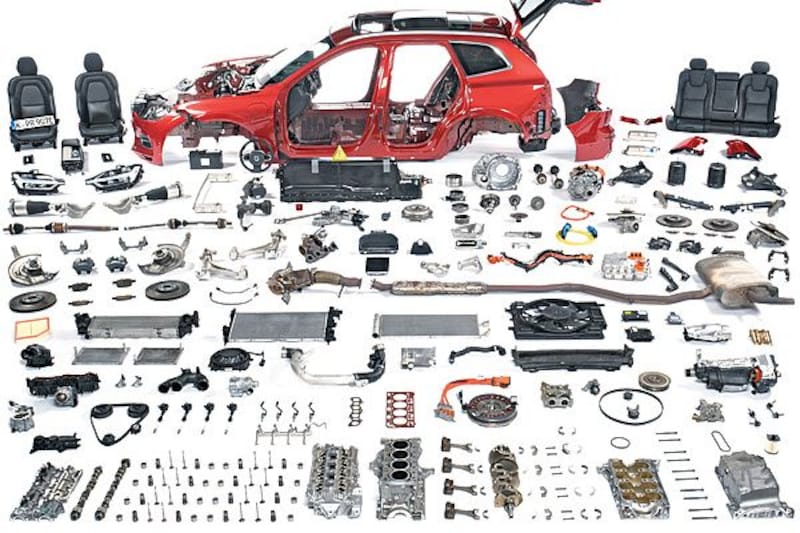Swedish rock in the surf

It might hurt you to see that we completely disassemble cars that are still in very good condition after an endurance test. They could last a while, right? You’re absolutely right about that, but if we don’t take our endurance testers apart, we won’t be able to see what condition they actually are in. So we are back in the workshop looking at a huge amount of parts, and at the bare body of a Volvo XC60 that has 102,007 kilometers on the clock.
For two years the Swede accompanied us on our travels across Europe. But first back to the beginning. On January 14, 2020, the SUV will enter our endurance test fleet. It is a T8, or a plug-in hybrid with a 2.0-liter four-cylinder petrol engine and an output of 303 + 14 hp plus an 87 hp electric motor on the rear axle, which provides a system power of 392 hp. The T8 has a starting price of more than 75 grand, which is quite a lot of money for a midsize SUV. The XC60 has a length of 4.69 meters and is therefore in the segment of the BMW X3 and the Mercedes-Benz GLC. But it is a very different car than, for example, those German opponents.
“A nice car for long journeys, comfortable seats with many adjustment options, fantastic rolling comfort and a quiet engine”, for example, we read in the logbook. Another comment concerns the ‘fantastic interior with a first-class appearance’. Another colleague: “This Volvo simply does not age. The leather on the seats, the plastics, the carpet, it all still looks like new.” We believe that other car manufacturers can learn from this. When it comes to the quality appearance of the materials, Volvo sets the bar very high. Not in other areas, such as multimedia. You’d better ignore the voice control, which is far too cumbersome. “The small tiles on the display are a disaster, they are at odds with Volvo’s safety claim,” said a colleague. It is therefore a wise decision by the Swedes to equip all new models with a Google-based infotainment system.

Volvo XC60
heavy drinker
Much more interesting, however, is the drivetrain, and in that area the Swede does very well with its modern technology. The XC60 is the first plug-in hybrid we’ve ever put to the test over 100,000 miles. Two elements stand out in this regard. First of all, the driving pleasure is a must; the T8 takes such great strides that you almost feel like you’re in a sports car. A system torque of 640 Nm, a sprint from 0 to 100 km/h in 6 seconds, those are resounding figures in a 2.2-ton SUV. In addition, it is striking that this oversized boy is a heavy drinker during long journeys. It is admittedly a plug-in, so you can plug in to power it. Theoretically, you cover a distance of 50 kilometers with a consumption of 2.5 liters per 100 km. In practice, however, the battery was empty after 30 kilometers and if you pull the whip over it, the consumption is two digits. If you take it easy, you get 1 in 10, but if you drive more enthusiastically, you should think about 1 in 7. If you travel a distance of 30 kilometers to and from work every day and regularly top up your electricity, you can use it sparingly. skip fuel. On average we came to 8.7 liters per 100 kilometers during our test round, or 1 to 11.5.
So it seems that you can save a lot with hybrid technology, but some colleagues think otherwise. “Despite recuperation, the battery also runs out too quickly in the city, consumption is too high – even compared to petrol models without hybrid technology,” we read, for example.
In a mid-term review, we can therefore conclude that the XC60 has two drawbacks according to the log: the multimedia system is too cumbersome and the consumption is too high. In other respects, the Volvo left a particularly good impression. But how did it hold up over 100,000 miles?

Exhaust manifold
This brings us back to the question of why we disassemble cars after the test. DEKRA Engineer Marcus Constantin takes a very critical look at the car, and finds what it takes. For example, he sees starting corrosion on the edges and welds of the front and rear axle carriers and a few chafing spots on the underside, where some rust is already visible. Not a pretty sight, but not alarming either. A good workshop solves that in one turn. More serious is the fact that the exhaust manifold seal at cylinder has one leak; the monolith on the first catalyst is fractured and the material on the second catalyst is cracked.
The exhaust manifold yields two penalty points, for the problem with the catalytic converters we note five.
Constantin: “You only hear it when you give it full throttle. It can go well for 20,000 kilometers, but also 200,000 kilometers.” Still, it’s a shame, because if the Volvo hadn’t dropped these stitches, it would have done even better.
The final conclusion of the DEKRA specialist: “Apart from these points, there is nothing to criticize about the overall condition of the car, given the distance it has covered during this endurance test.”
.
– Thanks for information from Autoweek.nl